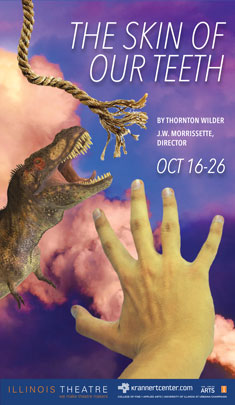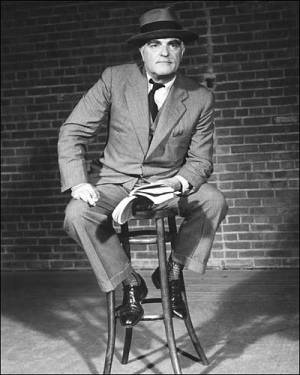For me, the most exciting parts of watching live theatre include witnessing a new and fresh interpretation of something I’ve seen dozens of times before, or being one of the first to view an inventive presentation of a new work that requires me to consider the focus of design and directorial elements of a production, especially when that concept or production is challenging to an audience. Face it, easy is boring! Even if I don’t fully agree with the interpretation, the debate of why they made the choices they’ve made is exhilarating to me. I like seeing conceptual works presented with a fresh and definite point of view. That’s kind of the point of theatre today from my perspective. If I wanted to see your production mimic a previous incarnation, I’d either travel to the original source or scout out the DVD and watch it in my PJs eating ice cream and finishing my manicure. Watching a predictable rehash isn’t my idea of a good time.
Sadly, in Champaign-Urbana, many theatregoers seem averse to the director and production staff’s freedom to take a risk with a creative interpretation. In response, many venues rely on the futile effort of trying to ape a professional production from Broadway or Off-Broadway—an exercise in futility since, let’s face it, most local venues haven’t any of the resources of a professional theatre company. And if we as audience members don’t embrace the creativity and innovation of lesser-funded companies, we might as well admit we take more joy in picking apart a production’s inferiority, rather than trying to see its merits. I’ve noted that audiences in C-U tend to embrace productions that look like poor relations of their more urbane counterparts and also tend to wrinkle their noses and pick at new and truly innovative interpretations because they require an audience to think and examine what the production team was thinking.
On occasion, our local critics seem to be equally lazy, and the combined effect is a bafflingly unsupportive environment from a community that purports to embrace and encourage the arts in many forms and at many levels. Maybe it’s easier to bitch about a production than to explore its merits, even when the focus differs from our concept of the work. I know I’ve been guilty of this in the past, and I also know I am not alone. But our audiences’ collective resistance to accepting challenging and innovative productions of familiar and new material has its consequences to the state of the arts in our community. After hearing the sniping over creative interpretations on more than one occasion, I’ve come to the conclusion that we can’t make our local audiences work too hard because they just won’t support it, and their collective apathy will cause venues to actually condemn creativity in the process. That’s pretty tragic, and it makes the arts less than they can be in a more supportive and inquisitive community.
My advice: SNAP OUT OF IT, C-U! SLAPI (Yep, I’m quoting Cher in Moonstruck, not to scold you, but to exhort you to want more…so just deal!)
 Why am I grumbling so? See, I just saw the first-rate opening night of Thornton Wilder’s The Skin of Our Teeth at Krannert Center for the Performing Arts with an audience that, collectively, just didn’t support the talented efforts of all those involved. True, I was surrounded by a lot of undergrads who were required to view the production for a class. They have an excuse: they’re children! (Wanna contradict me, junior? Then don’t act like SPOILED CHILDREN when viewing a piece of art! After that, I’ll accept that you’re an adult, and we can discuss the merit of your analysis!) That said, the adults also did a jaded version of what I just ranted about in the opening paragraphs, and the result was a cast and production having to struggle with an audience which seemed unaware of the need for audience responsiveness in live theatre! This production had the goods, and as is periodically the case, the audience gave them little praise for their efforts until the final curtain where some enthusiasm and warmth was deservedly bestowed
Why am I grumbling so? See, I just saw the first-rate opening night of Thornton Wilder’s The Skin of Our Teeth at Krannert Center for the Performing Arts with an audience that, collectively, just didn’t support the talented efforts of all those involved. True, I was surrounded by a lot of undergrads who were required to view the production for a class. They have an excuse: they’re children! (Wanna contradict me, junior? Then don’t act like SPOILED CHILDREN when viewing a piece of art! After that, I’ll accept that you’re an adult, and we can discuss the merit of your analysis!) That said, the adults also did a jaded version of what I just ranted about in the opening paragraphs, and the result was a cast and production having to struggle with an audience which seemed unaware of the need for audience responsiveness in live theatre! This production had the goods, and as is periodically the case, the audience gave them little praise for their efforts until the final curtain where some enthusiasm and warmth was deservedly bestowed
Thornton Wilder’s work is, well, work! He covers a lot of big issues and makes a dense evening of theatre with a lot of musings to think about! He has something to say and the Illinois Theatre production, under the enthusiastic direction of J.W.Morrissette, respects his words and sees them as timeless and worthy of sharing. Unlike Wilder’s more popular meditation, Our Town, an uneasy juxtaposition of young love and our pathetic mortality, The Skin of Our Teeth attempts to wrestle with the peculiar human proclivity to create and destroy in equal measures in a surreal landscape of a family that spans the full breadth of time! The Antrobus clan takes humanity from cave dwellers and onward through every mythologized natural disaster and World War to show the resilience of the human spirit against the depravity of their childish acts of self-destruction. Whether it deals with the quiet tyranny of infidelity and family dysfunction to the more global issues of why we decide that destroying another nation solves all of the victor’s problems, Wilder’s work tries to make the audience see both the agony and the joy of the human condition. It’s deep shit, kids, and it deserves our attention! When a man who survived the War to End All Wars (plus another war or two) speaks to the generation of the never-ending war, maybe we should give him a listen!
Morrissette is a talented director who still has the infectious joy of a kid when he’s asked to helm a production. His joy in theatre is apparent in every production he touches, and the life he breathes into vintage works is always unique and exhilarating! For this production, he has harnessed the talents of an incredible production design crew and a first-rate cast! Conceptually, the work could creak a bit and can run a goodly three hours, but Morrissette wisely sets a brisk and frenzied pace and gets the whole thing done in two hours and some change. (A note to the gods at U of I theatre: is a twenty minute intermission really necessary? Wouldn’t fifteen suffice?) His concept mines the current messages in this classic work, with a high-tech scenic design by the talented and creative Drew Lupson which includes full stage projections, a rotating and ever-morphing stage, and several geometric shapes that move effortlessly, becoming various states of the Antrobus home. Also of note is the vivid projection design by Lauren Tyler, the innovative and clever sound design by the duo of Yu-Yun Hsieh and D.J. Puuri, and the eye-popping costuming by designer Hasnfeng “Tiana” Liu. (The forties swimsuit for Sabina, and various haus frau and girlish couture for the Antrobus women were killer; and the men were spiffy, too!) And all of this was skillfully lit by lighting designer Michelle E. Benda!
This is a visually arresting production with expressive touches throughout and a shadow play of the history of war (courtesy of scenic change artist Christina Rainwater) that was both fascinating and moving in its execution against a grim, Big Top tarp expanse. Well done to all concerned. This is a smart, stunning, and well thought-out effort by both the director and his talented staff!
 The cast is just as impressive as the visuals of the piece. A special “holla” to the U of I acting program because these performances and those I’ve seen in the last two years are demonstrating a truly dynamic burst of energy in the acting instruction at that institution! Kudos to the teachers and students alike. In this production, the performances are spot on, starting with the lovely talents of Sarah Ruggles, so compelling in last year’s O Beautiful. Here, Ruggles gives a strong and finely drawn humanity to the buxom housekeeper with dubious morals, a vibrant creation of Wilder (seen, right) once played by the legendary Tallulah Bankhead. She steps in and out of character to ringmaster the story and move things along when needed. Her final moments before the rewind in Act III are just a delight! The conceit of the actors stepping in and out of character and revealing their humanity and the persona that lies beneath their character is an interesting one, even today, and it is wonderfully touching in the battle to the death of Antrobus family’s talented, but deeply flawed patriarch, played with booming authority by the talented Neal Moeller, and his black sheep son, played with a wicked, boyish malevolence and surprising vulnerability by Ryan Smetana. Both Moeller and Smetana command the stage when they are present, and possess a masculine swagger and a lost boy desperation that is combustible in the final moments of the piece.
The cast is just as impressive as the visuals of the piece. A special “holla” to the U of I acting program because these performances and those I’ve seen in the last two years are demonstrating a truly dynamic burst of energy in the acting instruction at that institution! Kudos to the teachers and students alike. In this production, the performances are spot on, starting with the lovely talents of Sarah Ruggles, so compelling in last year’s O Beautiful. Here, Ruggles gives a strong and finely drawn humanity to the buxom housekeeper with dubious morals, a vibrant creation of Wilder (seen, right) once played by the legendary Tallulah Bankhead. She steps in and out of character to ringmaster the story and move things along when needed. Her final moments before the rewind in Act III are just a delight! The conceit of the actors stepping in and out of character and revealing their humanity and the persona that lies beneath their character is an interesting one, even today, and it is wonderfully touching in the battle to the death of Antrobus family’s talented, but deeply flawed patriarch, played with booming authority by the talented Neal Moeller, and his black sheep son, played with a wicked, boyish malevolence and surprising vulnerability by Ryan Smetana. Both Moeller and Smetana command the stage when they are present, and possess a masculine swagger and a lost boy desperation that is combustible in the final moments of the piece.
The women of the Antrobus clan are equally adept. Cassandra Cushman’s matriarch possesses a lonely, subservient quality at the start of the play and an incredibly moving solidness in her monologue in Act II where she throws a message into the apocalyptic sea for women everywhere. She also possesses a lovely singing voice as she comforts her deeply damaged son. Margaret Kellas, as the Antrobus’ precocious daughter, transforms from child to woman before our eyes with a sweet innocence in her early moments, yielding to a sexually curious girl and weary single mother who bears the burden of her curiosity in the final moments of the piece. The entire family is stellar, though the women are sometimes harder to hear in the massive space of the auditorium.
Fine support is given by Brandon Rivera, whose transgender psychic literally steals the boardwalk and every moment he’s on the stage. He is just absolutely delicious and exudes confidence every second he’s on! Bravo! Dina Monk is also engaging and fun as the family’s pet dinosaur, playing well off of Kyle Bullock and Clara Byczkowski massive Mammoth. Their skeletal costumes are incredibly clever and move well as they amble through the first act.
The entire ensemble has a wonderful energy and the professionalism to give a top-notch performance even when the audience is less that effusive. They deserve better, so challenge yourselves and go see this wonderfully inventive production before it ends! The show continues through October 26, and tickets can be reserved at the Krannert Center website.








